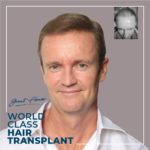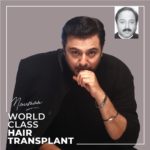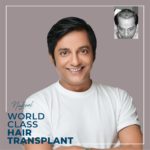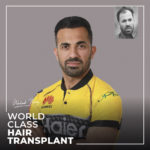Density & Dense Packing of FUT
- Home
- Hair Transplant Surgery
- Density & Dense Packing of FUT
More is better. This axiom serves as the foundation for modern hair transplantation and should always be referred to when making any decision regarding hair restoration surgery. For example, knowing the concentration of hair to be transplanted into your balding area is key to foretelling the results. Or, knowing how many grafts a hair transplant doctor and his team are capable of transplanting in a single session is indicative of their skill level. Or, knowing how many grafts in total a doctor has transplanted over the years is testament to their level of experience.
Patients become the most confused when they go to two different doctors and are told two radically different things. One of the most common is the number of grafts to be hair transplanted. The actual number of total grafts is fairly useless information, unless the area of bald scalp to be covered by that number is even. Often we have patients visit us for consultation who have already been to other hair lo clinic offices. They state that they had been told that they need, say, 1,500 hair grafts; but when asked by Dr. Muhammad Nasir Rashid over how much of the scalp it was to be placed, they usually pointed to the entire bald area, or simply didn’t know.
What is not understood is that most hair transplant clinics claim loudly to be able to transplant large numbers of grafts in a single session, but are quietly limited to placement of these grafts only over large total areas. Their concentration of hair are typically low with an average of only 16-20 grafts per square centimeter, or less, because they are spaced out over so much bald skin. Make no mistake, the reason they use this low concentration is because it is easier and faster to perform. The problem is that this method results too often in a less than adequate hair density that also doesn’t provide any significant cosmetic improvement.
The solution is to implant 40-70 grafts per square centimeter on average as Dr. Muhammad Nasir Rashid routinely does, IN ONE SESSION. This necessitates a skill level and experience that goes far beyond the standard level. There are very, very few doctors in the World. that perform at this level consistently , and is the main reason why a perspective patient should meet and interview his doctor very carefully.
One of the biggest fallacies in hair restoration surgery today is promulgated by inexperienced physicians who claim that they VOLUNTARILY perform low density transplantation for the patient’s benefit. The reason most often given is a supposed insufficiency on the part of the scalp’s blood supply to nourish a large number of transplants. This is simply untrue, and the real reason is usually becasues THEY do not posses suffienct skill, experience, staff, and instrumentation to perform a proper high density transplant. The “insufficient bloood supply” reason is usually a cover for their own insufficiencies, and little else. This fallacy has been disproved by this office and others like ours around the world who perform successful high-density hair transplants routinely.
Density and Area will always compete with one another for dominance when planning hair restoration surgery. This is why the operating physician, and only the operating hair transplant physician should do the initial consult (not a consultant or a different doctor). There are many variables involved, both medical and cosmetic, that must be addressed and balanced to maximize resources and results. A properly performed high density transplant can, in many cases, save the patient from requiring a second or third procedure. And, unlike the case for the number of hairs, the fewer surgeries… the better!
The advent of the follicular unit has also allowed us to implant a large number of grafts in very close proximity and achieve excellent growth rates. In many cases densities may range from 30 to 45 grafts per square centimetre.
More conventional methods required that a section of skin be removed so that the graft can be placed into the recipient hole. This removal of scalp, even though small, disrupts the blood vessels and has the affect of reducing the blood supply to the scalp. This ultimately limits the number of grafts that could be successfully placed to about 500 to 800 per session so that numerous procedures are required over a long period of time to achieve the final result. Using follicular units, the removal of a section of skin to make a recipient hole is unnecessary.
Due to the small size of the grafts it is now possible to place the grafts into incisions made with hypodermic needles. This method does not remove blood vessels and therefore leaves the vital blood flow intact to supply the new grafts. This has allowed us to place a very large number of grafts in one sitting, the grafts are placed very close together and achieve consistent and reliable results with growth rates in excess of 95%. Dense packing is often performed in conjunction with the megasession.
Some time ago, several individuals suggested a representative cross section of what someone could expect with specific numbers of grafts per square cm. Since we have been doing exclusively follicular unit transplantation since 1988, our experience with every possible number of grafts producing every possible final hair density is extensive.
To demonstrate these varying densities over time and the results a patient can expect, I have gathered together a number of cases shown below dating from 1991 through to 2002. I have tried to cover the full range of potential graft densities.
During the early years of follicular unit hair transplantation, when the technology required to perform follicular unit transplantation was being developed, it was not uncommon to transplant densities of only eight to ten grafts per square cm.
R 8 grafts/ square cm
RC 10 grafts/ square cm
With time the need for more grafts per square centimeter to accomplish cosmetic density became obvious. By 1991 20 grafts per square cm were typical for the average case.
Then by 1994 graft densities of 40 grafts per square cm were not uncommon.
I am quite certain that the first case to exceed 40 grafts per square cm was planted by our staff in 1994, transplanting the majority of the frontal hairline at a graft density of 40 to 45 grafts per square cm.
Today the majority of follicular unit hair transplants are done with graft densities ranging from 20 to 40 grafts per square cm in order that significant zones may be covered. Obviously, the availability of donor hair, the goals of each individual patient, and patient finances determine the graft densities transplanted.
In addition, it takes a great deal of experience for clinics to be able to transplant significant numbers of grafts within reasonable timeframes at these high densities.
There are many other variables, which determine the final cosmetic result such as hair shaft diameter, curl, hair/skin color match, etc. Therefore no absolute statements can be made regarding any one individual’s results.






